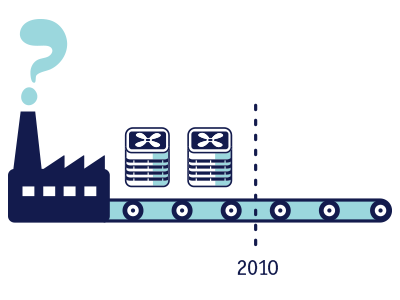Why Alternative
Refrigerants Make Sense
The benefits of retrofitting existing air conditioners
If your air conditioner was manufactured before 2010, it’s worth learning about the features, benefits and reasoning behind the use of alternative refrigerants. For example, if your system ever develops a leak, you’ll have to make some decisions about whether to repair it, replace it or retrofit it.
Most A/C units manufactured before 2010 use a refrigerant called R-22. As of January 1, 2020, it's illegal to make or import R-22 in the US. So, it’s going to become increasingly tricky and expensive to top your older system off with a refrigerant like R-22. But cost isn’t the only factor to consider.

Pre-2010
A/C units may require alternative refrigerants or can be replaced.
The benefits of alternative refrigerants
At their most basic level, alternative refrigerants make your A/C unit do what it does best: cool your home. They’re better for the environment. They're more affordable than refrigerants like R-22. And using them will make repairing and maintaining your A/C much easier.
Why are alternative refrigerants better for the environment?
One of the most impressive benefits of alternative refrigerants like MO99, R-410A, and others is their decreased impact on the environment.
Before today’s alternative refrigerants, we used hydrochlorofluorocarbons (HCFCs) like Freon®-22, or R-22. HCFCs are less damaging than previous refrigerants, but they still “survive” in the Earth’s ozone layer for 2 to 40 years. Because they’re damaging to the Earth’s ozone, the EPA mandated their phase out with the Clean Air Act of 2010. R-22 may no longer be produced or imported into the US as of January 1, 2020.
Alternative refrigerants fall under the category of hydrofluorocarbons (HFCs). They contain no chlorine, which is great news for the Earth because they don’t deplete the planet’s upper atmosphere.

Why do alternative refrigerants cost less?
As mentioned, the EPA banned the production and import of R-22 because of the harmful impact it has on the environment. As the supply of R-22 diminishes and it becomes harder and harder to find, the cost will continue to rise.
Since the beginning of 2016, the price of R-22 has more than doubled. Now that we've passed the EPA’s mandated end-of- production date for R-22, this number is expected to only increase.
Alternative refrigerants, on the other hand, are readily available and are not burdened with the production restrictions associated with R-22. This means the supply remains constant, creating far more competitive prices for the consumer.
Why do alternative refrigerants make it easier to repair or maintain an existing system?
One of the biggest challenges Service Contractors encounter is finding the parts they need to fix or maintain an A/C. As R-22 becomes scarce, it can be extremely difficult or even impossible for Service Contractors to get their hands on it. This lack of availability can mean long delays in getting a repair completed and cool air blowing again.

To understand why chlorine’s impact on the Earth’s ozone layer is so damaging, it’s helpful to understand the basics behind What Are Refrigerants?
The benefits of retrofitting an air conditioner for alternative refrigerants
The good news about older A/C systems that use R-22 is that they can be retrofitted to use alternative refrigerants. This relatively straightforward process lets homeowners with an older system get more life out of their A/C for a lot less money. In fact, there are several benefits to a retrofit, including the following.
Contractors don’t always carry R-22
R-22 is becoming extremely expensive as the government continues to phase out its production. This makes it much harder for Service Contractors to find and use. An R-22 alternative makes the process much easier.
Retrofitting makes your A/C more serviceable in the future
R-22 is obsolete, and moving to a Freon alternative the next time you need A/C repairs will make future repairs easier and faster (which means you get a cool house faster).
Quite simply, alternative refrigerants let you fix your A/C faster and for less money, all while protecting the environment, than hunting for R-22.

Increase your
speed of service
R-22 is expensive and hard to source, but alternative refrigerants are widely available. Using them will help get your home cooler, faster.
Frequently asked questions about air conditioners and refrigerants
What is a Refrigerant?
Refrigerants, also called coolants, are the chemical compounds that work with your air conditioning system to provide your home with cool air. R-22 is the most common type of refrigerant found in air conditioners that were manufactured before 2010.
There are different types of refrigerants, and the use of these compounds is regulated by the Environmental Protection Agency. That’s because their usage has an impact on the environment, and our understanding of that impact continues to develop and evolve over time.
WHAT IS R-22?
R-22 is a hydrochlorofluorocarbons (HCFC) and a type of refrigerant gas that has been used in air conditioning systems for many years.
The EPA’s Clean Air Act of 2010 mandated the phase-out of R-22 production, because researchers discovered that it depleted the ozone. The government mandated a 90% reduction in R-22 production by 2015, and a 99.5% reduction by 2020.
HOW CAN I TELL WHEN MY AIR CONDITIONER WAS MANUFACTURED?
Manufacturers always include the date of manufacture in the air conditioning unit’s serial number, though they can be displayed differently.
The manufacture date, sometimes written as MFG date, usually appears on the nameplate of your A/C unit, near your serial and model number.
If you can’t find the manufacture date, but you do see the serial number and model number, simply enter the serial number, model number, and the brand name of your A/C into any search engine. It should bring the manufacture date up for you.
WHAT ARE ALTERNATIVE REFRIGERANTS?
Since HCFCs like R-22 were found to be environmentally damaging, it was determined that there needed to be another option. Alternative refrigerants are classified as hydrofluorocarbons (HFCs) and they don’t contain any ozone-depleting chlorine. Aside from being better for the environment, they’re more affordable than R-22, work efficiently and increase the serviceability of your A/C unit.
If your air conditioner uses R-22 and develops a leak or needs another repair, your HVAC technician may recommend that your existing A/C unit be retrofitted to accept an alternative refrigerant.
To learn more about the benefits of alternative refrigerants, click here.
CAN’T I JUST USE AN ALTERNATIVE REFRIGERANT IN MY OLDER AIR CONDITIONING SYSTEM?
If your air conditioner uses R-22 refrigerant, you can’t just top off with an alternative refrigerant. Your system would need to be retrofitted in order to allow the use of alternative refrigerants.
WHAT DOES IT MEAN TO “TOP OFF,” “RECHARGE” OR PERFORM A “GAS AND GO” ON AN AIR CONDITIONING SYSTEM?
When talking about adding more refrigerant to an air conditioning unit, technicians refer to the process as “topping off” or “recharging”.
Essentially, the chemical refrigerant inside of the unit is being refilled. When you hear the term “charging” it’s also a reference to adding refrigerant into the air conditioning system.
CAN I TOP OFF MY AIR CONDITIONER BY MYSELF?
No, you cannot top off your air conditioner’s refrigerant on your own. Federal law regulates the use and installation of refrigerants and special licensure and/or certifications are required for the professionals who work with these chemicals.
HOW CAN I TELL WHEN MY AIR CONDITIONER NEEDS MORE REFRIGERANT?
When your air conditioner needs to be topped off or recharged with more refrigerant, one of the first signs is warm or room temperature air.
However, there could be any number of reasons for a malfunctioning air conditioner. If you have a Home Warranty Service Agreement from 2-10 HBW, you can place a request for service and 2-10 HBW will dispatch a service contractor to your home. If you do not have a Home Warranty Service Agreement, you should call an HVAC technician to assess your system’s functionality.
WHAT SHOULD I DO IF MY AIR CONDITIONER BREAKS DOWN?
If you think you might have a problem with your air conditioner and you have a Home Warranty Service Agreement from 2-10 HBW, you can place a service request and 2-10 HBW will dispatch a service contractor to your home. If you do not have a Home Warranty Service Agreement, you can call an HVAC technician to assess your system’s functionality.
IS IT ILLEGAL TO BUY AN AIR CONDITIONER THAT USES R-22?
This is a problem you’re unlikely to encounter, since the manufacture and installation of new equipment using R-22 is now illegal.
Remember that you can still continue to service and maintain your existing air conditioner, even if it uses R-22. You just can’t install a new air conditioner that uses R-22.
HOW MUCH DOES IT COST TO USE AN ALTERNATIVE REFRIGERANT?
The costs of retrofitting an existing air conditioner to use alternative refrigerants will vary depending on the type of retrofitting that’s needed.
WHY CAN’T I JUST HAVE LEAKS IN MY A/C REPAIRED?
Yes. There are products in the market that can do an immediate and effective job of repairing and sealing refrigerant leaks even if the technician cannot find the leak’s location.
WHY WOULD MY AIR CONDITIONER NEED ALTERNATIVE REFRIGERANT?
Air conditioners can develop leaks over the course of normal use, which is one of the primary reasons your refrigerant would need to be topped off.
If your air conditioner was manufactured before 2013, it likely uses R-22 refrigerant. Due to EPA regulations this gas is good as gold — it’s expensive and hard to find.
WHAT IF MY R-22 IS ONLY SLIGHTLY LOW? WILL TOPPING OFF BE CHEAPER OR EASIER?
Topping off an A/C system with a known leak is illegal, but once the leak has been diagnosed and addressed by an HVAC technician, it can be a viable practice. Topping off with R-22 may be more economical in the short term. But, in the long run, R-22 is becoming more difficult to find, and that’s if you can find a technician who will even work with R-22 (many will simply refer you to someone else). Further, the technician can guesstimate how many pounds you’ll need, but you won’t know the final count until the refrigerant is being replaced.
WHAT DOES THE RETROFITTING PROCESS LOOK LIKE?
The retrofitting process will look different based on the type of alternative refrigerant being used. Some retrofits are easy and straightforward, with minimal or no equipment replacements needed.
Other retrofits are more complex and require additional components. For more information on how an air conditioner gets retrofitted, review How An Air Older Air Conditioner Gets Retrofitted For Alternative Refrigerants.
DO ALTERNATIVE REFRIGERANTS DEPLETE THE OZONE LAYER?
No, alternative refrigerants do not deplete the ozone layer, which is why the EPA is phasing out R-22 and mandating the use of these new compounds.
SHOULD I REPLACE MY OLD AIR CONDITIONER IF IT ISN’T BROKEN YET?
If having a new, modern, and more efficient system is important to you, you might consider replacing your air conditioner.






